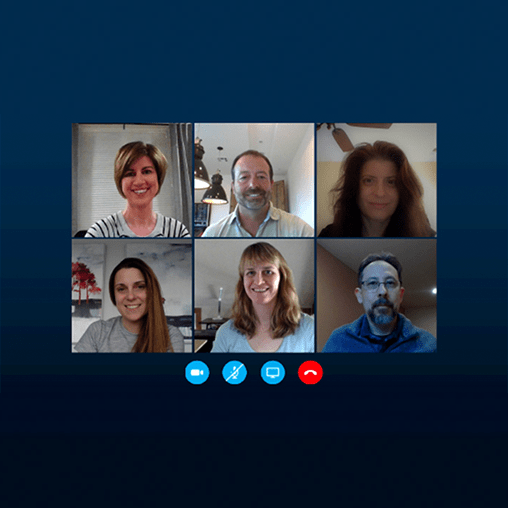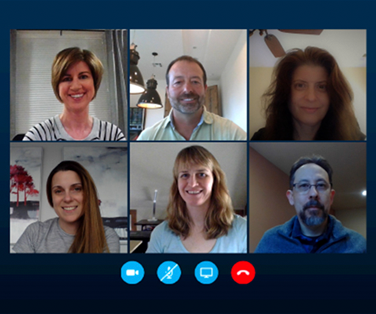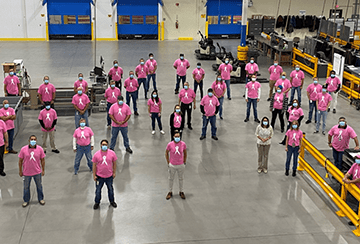Many Amgen staff are making the transition to remote work for the first time in their careers. For some, this may be a transition that eases concerns around commutes, childcare and COVID-19 exposure. Others may be confronted with new technologies to master and concerns about not being face-to-face with their teams. Who likely knows more about this world than anyone else? Remote workers. Amgen had a remote workforce long before COVID-19. So we asked them, along with some of the company’s HR professionals, for advice.
Dealing with Technology Challenges
Technology adaptation can be one of the biggest challenges people face when they start working remotely.
“Sometimes you’ll be less productive than you want to be,” says Tom Wrona, senior counsel for Intellectual Property & Litigation. “Don’t stress—there will be just as many instances of extreme productivity because you’re not dealing with all the distractions in the office.”
Make Mental Wellness a Priority
“Mental wellness is as equally important as physical wellness,” says Ying Huang, executive director of Human Resources for Amgen’s Japan and Asia-Pacific (JAPAC) region.
“You may be much busier during this time period, even working from home,” she adds. “Take regular breaks so that you can eat, sleep and exercise. Even block time in your calendar so that these breaks are not quickly taken up by back-to-back calls.”
Connecting with Team Members
“Use the phone and video conferencing as much as possible to build and maintain personal connections,” says Mike Penn, senior counsel for Intellectual Property & Litigation. “It’s often easier to use email to communicate, but that can really be isolating at times.”
Sara Jones, a senior communications specialist in Switzerland, recommends scheduling a few calls as a way to take virtual coffee breaks. “You don’t have to talk about work—just do general check ins as you would if you went for a coffee in the office,” she says.
WFH While Parenting
Juggling work and family priorities has always been a challenge for people who work from home, and that challenge has grown even more common as schools close to slow the spread of COVID-19. Jones finds herself balancing work with keeping her 5-year-old son active and amused since he’s now at home during the day.
Penn says the first few weeks of working from home while parenting requires some adjustment. “Then everyone gets into a routine and we all learn to work around each other’s schedules,” he says. “And the closed office door means Dad is on a call, so don’t just barge in!”
Pets Too!
Aside from the 15-second commute upstairs to her office, Katherine Walton, a senior manager for Information Systems, says one of her favorite things about remote work is having her dog Cooper by her side. “He comes to my office right at 5 p.m. to let me know it’s time to stop working and go for a walk,” she says.
On the other hand, one of her most embarrassing conference call experiences happened when Cooper was loudly squeaking a toy while she was on the line with about 50 other people. “I tried to mute my line so I could yell ‘Cooper that’s enough!’, but apparently my mic doesn’t mute for several seconds after I click the button,” she says. “At the end, the person running the call (whom I’ve never met in person) said ‘thanks everyone, thanks Cooper!’ Now I hide all his squeaky toys during the day.”
Establishing a Routine
Working from home puts your personal and professional lives in close proximity, and it can be easy to get distracted by family, hobbies or social media. Brandon Eguchi, a contract worker for Digital and Diagnostics Quality, says distraction is his biggest adversary as a remote worker, one that he solves by having a dedicated workspace and a daily routine.
"I have a separate room with a desk, ergonomic office chair, footrest and good lighting,” he says. “I start at the same time every day and work through my day as though I was on-site. When the weather permits, I ‘commute to work' by going for a walk around the block.”
Maintaining Focus
Laura Bloss, executive director for Regulatory Affairs, admits her biggest struggle as a remote worker is maintaining focus during long conference call meetings with no one else around. “I have several meetings on my calendar that last more than two hours, and it can be difficult to pay attention and follow along," she says. “I have to move my phone to the other side of the room and keep my screen set to the meeting materials.”
Embracing Flexibility
Working from home can mean having more flexibility over when and how you work, but that can also make it hard to unplug and step away from work at the end of the day. “Having a separate space to work is incredibly important,” Walton says. “Separating work life from home life enables me to physically disconnect from work at the end of the workday.”
Erin Spiker, a senior manager for Regulatory Affairs, says she uses flexibility to her advantage by planning out her days for maximum productivity. “I clearly communicate my working hours to my team and internal customers in different time zones," she says. “I do most of my independent work during the mornings, leaving more availability for meetings and collaboration later in the day.”





